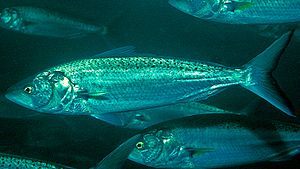Arripis trutta facts for kids
Quick facts for kids Arripis trutta |
|
|---|---|
 |
|
| Scientific classification | |
| Synonyms | |
|
The kahawai (scientific name: Arripis trutta) is a type of fish found in the cooler waters around Australia and New Zealand. In Australia, it's often called the Australian salmon. Even though its name sounds like "salmon" or "trout," it's not actually related to those fish.
Other common names for this fish include Eastern Australian salmon, bay trout, and blackback salmon. It's one of four species in the Arripis family.
Contents
What Does the Kahawai Look Like?
The kahawai has a sleek, long body that helps it swim fast. It has a bony ridge under each eye, which is bumpy on younger fish but smooth on older ones. Its tail fin is about as long as its head.
These fish are dark bluish-green on top and shiny silver-white underneath. Young kahawai have golden stripes on their sides, which turn into large spots as they grow up. Their pectoral (side) fins are bright yellow, and their tail and spiny dorsal (back) fins have black edges.
The kahawai can grow up to 89 centimetres (35 in) long, but they are usually around 47 centimetres (19 in). The heaviest one ever recorded weighed 9.4 kilograms (21 lb).
Where Do Kahawai Live?
Kahawai live in the southwestern Pacific Ocean, near Australia and New Zealand. In Australia, you can find them from Queensland down to Victoria and northern Tasmania. They are also seen around Lord Howe Island and Norfolk Island.
In New Zealand, they live all around the coast, but they are more common north of Kaikōura on the South Island. They also live near the Chatham Islands and Kermadec Islands.
Kahawai's Home and Habits
Kahawai are fish that travel long distances, sometimes thousands of kilometers! Adult kahawai gather in huge groups, called schools, near ocean beaches and open coastlines. They can even swim into rivers.
Young kahawai live in smaller schools in calmer places like bays and estuaries. These younger fish are mostly found in the southern parts of where kahawai live.
Kahawai are carnivores, meaning they eat other animals. They mostly hunt small fish that swim in open water and tiny ocean creatures like krill. When they are young, they eat different kinds of crustaceans and worms. But as they get older, they prefer to eat small schooling fish like pilchards, sprats, and anchovies.
Scientists have noticed that what adult kahawai eat has changed since the late 1900s. They used to eat more krill and squid, which live in cooler waters. Now, they mostly eat small baitfish. This change might be because the East Australian Current, which brings warm water, has moved further south. This shift in ocean currents is one way we can see the effects of global warming on marine life.
Kahawai are an important part of the ocean food chain. Bigger predators like seals, dolphins, and sharks hunt them. When kahawai hunt their prey, they push the smaller fish towards the surface. This makes it easier for seabirds to catch them. For example, the white-fronted tern is sometimes called the "kahawai bird" because it often feeds alongside kahawai. Fishermen even look for flocks of these birds to find kahawai schools!
How Do Kahawai Reproduce?
The kahawai population in Australia lays its eggs (spawns) in the surf zone between Lakes Entrance in Victoria and Bermagui in New South Wales. This happens in late spring and summer.
Kahawai usually start to reproduce when they are about four years old and around 39 centimetres (15 in) long. They can live for up to 26 years.
Fishing for Kahawai
Kahawai are caught in coastal waters, often near river mouths and beaches. Commercial fishermen usually catch them using large nets called purse seines. Sometimes, they even use planes to spot the big schools of fish. Kahawai can also be caught by accident (called bycatch) in nets meant for other schooling fish like snapper or mackerel.
Most commercial kahawai fishing happens in southern New South Wales and Eastern Victoria. The meat of the kahawai isn't very popular for people to eat, so a lot of the fish caught are used for pet food or bait. In New Zealand, the main fishing areas are north of Kaikoura, off the North Island, and in the Cook Strait. New Zealand manages its kahawai fishery to make sure there are enough fish for the future.
Catching Kahawai for Sport
Kahawai are very popular with people who fish for fun. Anglers, especially those fishing from beaches and rocks, love to catch them. They often use light fishing gear or try fly fishing. Kahawai are known for being a "sporting catch" because they put up a good fight!

